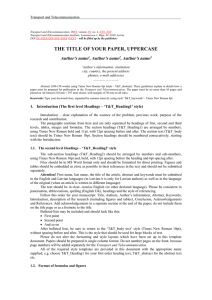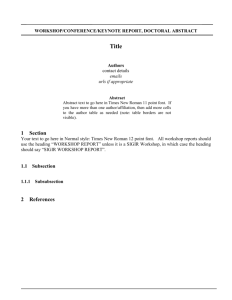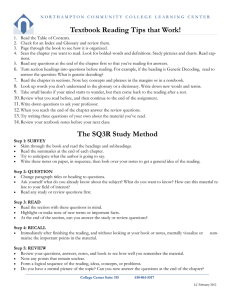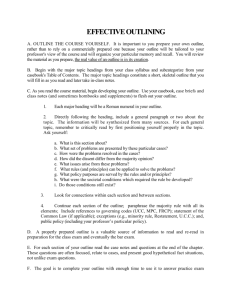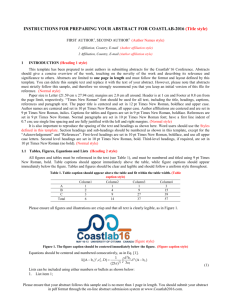Paper Template (.docx)
advertisement
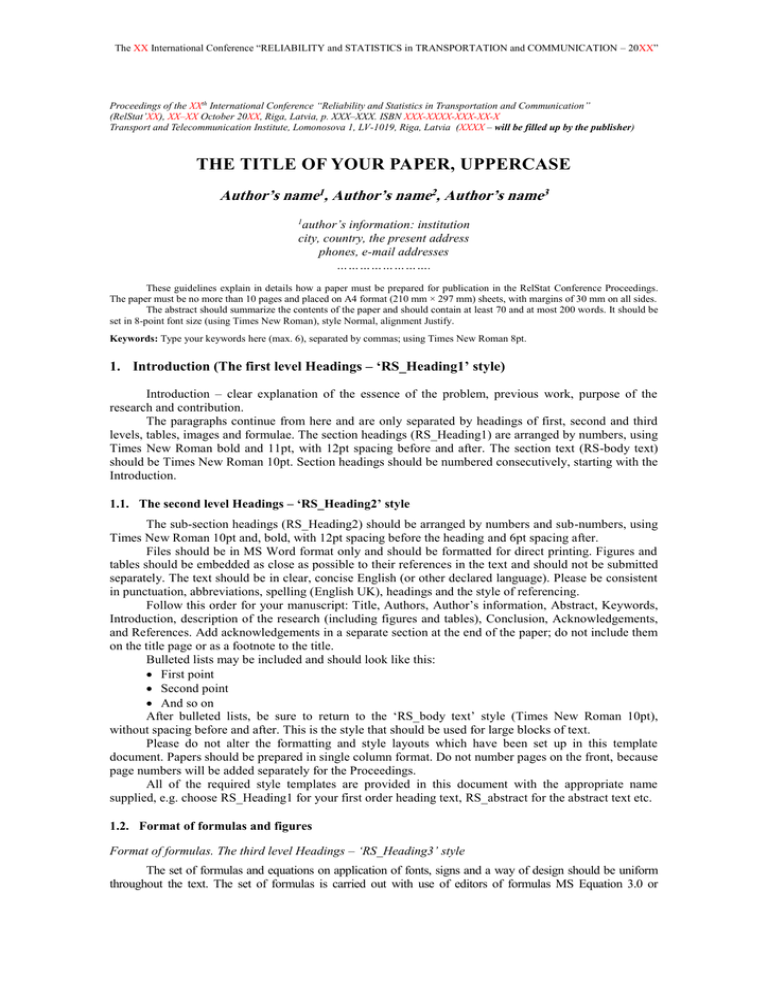
The XX International Conference “RELIABILITY and STATISTICS in TRANSPORTATION and COMMUNICATION – 20XX” Proceedings of the XXth International Conference “Reliability and Statistics in Transportation and Communication” (RelStat’XX), XX–XX October 20XX, Riga, Latvia, p. XXX–XXX. ISBN XXX-XXXX-XXX-XX-X Transport and Telecommunication Institute, Lomonosova 1, LV-1019, Riga, Latvia (XXXX – will be filled up by the publisher) THE TITLE OF YOUR PAPER, UPPERCASE Author’s name1, Author’s name2, Author’s name3 author’s information: institution city, country, the present address phones, e-mail addresses ……………………. 1 These guidelines explain in details how a paper must be prepared for publication in the RelStat Conference Proceedings. The paper must be no more than 10 pages and placed on A4 format (210 mm × 297 mm) sheets, with margins of 30 mm on all sides. The abstract should summarize the contents of the paper and should contain at least 70 and at most 200 words. It should be set in 8-point font size (using Times New Roman), style Normal, alignment Justify. Keywords: Type your keywords here (max. 6), separated by commas; using Times New Roman 8pt. 1. Introduction (The first level Headings – ‘RS_Heading1’ style) Introduction – clear explanation of the essence of the problem, previous work, purpose of the research and contribution. The paragraphs continue from here and are only separated by headings of first, second and third levels, tables, images and formulae. The section headings (RS_Heading1) are arranged by numbers, using Times New Roman bold and 11pt, with 12pt spacing before and after. The section text (RS-body text) should be Times New Roman 10pt. Section headings should be numbered consecutively, starting with the Introduction. 1.1. The second level Headings – ‘RS_Heading2’ style The sub-section headings (RS_Heading2) should be arranged by numbers and sub-numbers, using Times New Roman 10pt and, bold, with 12pt spacing before the heading and 6pt spacing after. Files should be in MS Word format only and should be formatted for direct printing. Figures and tables should be embedded as close as possible to their references in the text and should not be submitted separately. The text should be in clear, concise English (or other declared language). Please be consistent in punctuation, abbreviations, spelling (English UK), headings and the style of referencing. Follow this order for your manuscript: Title, Authors, Author’s information, Abstract, Keywords, Introduction, description of the research (including figures and tables), Conclusion, Acknowledgements, and References. Add acknowledgements in a separate section at the end of the paper; do not include them on the title page or as a footnote to the title. Bulleted lists may be included and should look like this: First point Second point And so on After bulleted lists, be sure to return to the ‘RS_body text’ style (Times New Roman 10pt), without spacing before and after. This is the style that should be used for large blocks of text. Please do not alter the formatting and style layouts which have been set up in this template document. Papers should be prepared in single column format. Do not number pages on the front, because page numbers will be added separately for the Proceedings. All of the required style templates are provided in this document with the appropriate name supplied, e.g. choose RS_Heading1 for your first order heading text, RS_abstract for the abstract text etc. 1.2. Format of formulas and figures Format of formulas. The third level Headings – ‘RS_Heading3’ style The set of formulas and equations on application of fonts, signs and a way of design should be uniform throughout the text. The set of formulas is carried out with use of editors of formulas MS Equation 3.0 or Session X. MathType. The formula with a number – the formula itself should be located on the left edge of the text, but a number – on the right one. Font sizes for equations are the following: 11pt – full, 7pt – subscripts/superscripts, 5pt – sub-subscripts/superscripts, 16pt – symbols, 11pt – subsymbols. a2 b2 (1) Equations should use the style ‘RS_equation’ Format of figures All figures must be centred. Figure number and caption always appear below the figure (‘RS_figure_caption’ style, Times New Roman 8pt with 6pt spacing before and 12pt after). Figure 1. This is figure caption Diagrams, figures and photographs must be of high quality, in format *.TIFF, *.JPG, *.BMP with resolution not less than 300 dpi. Also formats *.CDR, *.PSD are possible. Combination of figures in format, for instance, *.TIFF with elements of the in-built Figure Editor in MS Word is prohibited. 1.3. Format of Tables Table Number and Title should be placed above tables, Alignment left, with 12pt spacing before and 6pt after (‘RS_table_head’ style, Times New Roman 8pt). Table 1. This is an example of a Table Heading Text Text Heading Text Text Heading Text Text Insert one line after the table (if not a heading). The table style should be ‘RS_table_text’ Times New Roman 8pt. 1.4. Format of references References and citations should follow the Harvard (Autor, date) System Convention. As example, references should be identified in the main text as follows: The results (Vroom, 1960) were quite striking. In recent studies by Smith (1999a, 1999b, 1999c)… Earlier (Vroom and Jago, 1988) we described a systematic evaluation ... Besides that, all references should be cited in the text. No numbers with or without brackets should be used to cite or to list the references. References should be listed at the end of the paper and should first be arranged alphabetically and then in chronological order if there is more than one reference for a given set of authors. More than one reference from the same author(s) in the same year must be identified by the letters “a”, “b”, “c”, etc., placed after the year of publication. The correct format for references is the following: 1. Book: Author(s). (Year of publication) Book title (in Italics). Place of publication: Publisher. Example: Kayston, M. and Fried, W. R. (1969) Avionic Navigation Systems. New York: John Wiley and Sons Inc. 2. Conference Proceedings: Author(s). (Year of publication) Title of an article. In: Conference name, Date, Place of publication: Publisher, Page range. Example: Gibson, E.J. (1977) The performance concept in building. In: Proceedings of the 7th CIB Triennial Congress, Edinburgh, September 1977. London: Construction Research International, pp. 129-136. 3. Journal article: Author(s). (Year of publication) Article title. Journal Title, Volume (issue), range of pages. DOI. Example: Nikora, V. (2006) Hydrodynamics of aquatic ecosystems. Acta Geophysica, 55(1), 3– 10. DOI:10.2478/s11600-006-0043-6. 4. Report: Author(s). (Year of publication) Title. Place of publication: Publisher. (Report number). The XX International Conference “RELIABILITY and STATISTICS in TRANSPORTATION and COMMUNICATION – 20XX” Example: Osgood, D. W. and Wilson, J. K. (1990) Covariation of adolescent health problems. Lincoln: University of Nebraska. (NTIS No. PB 91-154 377/AS). 5. Government publication: Institution name. (Year of publication) Title. Place of publication: Publisher. Example: Ministerial Council on Drug Strategy. (1997) The national drug strategy: Mapping the future. Canberra: Australian Government Publishing Service. 2. Conclusions Conclusion section (this is mandatory) – should clearly indicate on the advantages, limitations and possible applications. Acknowledgements (‘RS_Heading_nonum’ style) If any, should be placed before the references section without numbering. The Acknowledgements heading should be in bold, using the style ‘RS_Heading_nonum’. Acknowledgements (if present) mention some specialists, grants and foundations connected with the presented paper. References (‘RS_Heading_nonum’ style) The References heading should be in bold but without numbers, using the style ‘RS_Heading_nonum’. 1. 2. 3. 4. 5. Gibson, E.J. (1977) The performance concept in building. In: Proceedings of the 7th CIB Triennial Congress, Edinburgh, September 1977. London: Construction Research International, pp. 129-136. Kayston, M. and Fried, W. R. (1969) Avionic Navigation Systems. New York: John Wiley and Sons Inc. Ministerial Council on Drug Strategy. (1997) The national drug strategy: Mapping the future. Canberra: Australian Government Publishing Service. Nikora, V. (2006) Hydrodynamics of aquatic ecosystems. Acta Geophysica, 55(1), 3–10. DOI:10.2478/s11600-006-0043-6. Osgood, D. W., and Wilson, J. K. (1990) Covariation of adolescent health problems. Lincoln: University of Nebraska. (NTIS No. PB 91-154 377/AS). The references style should be ‘RS_references’ Times New Roman 10pt. Articles poorly produced or incorrectly formatted may not be included in the proceedings.
